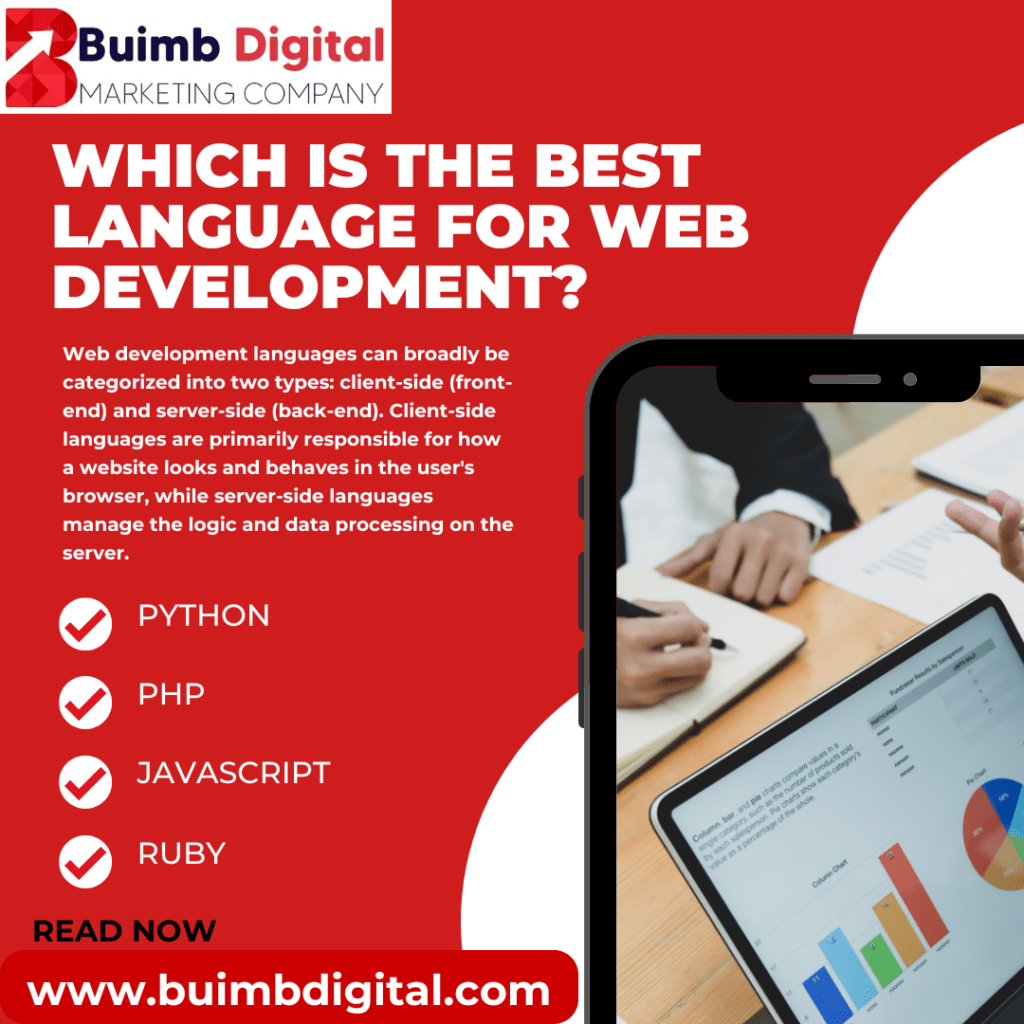Which is the Best Language for Web Development?
Web development languages can broadly be categorized into two types: client-side (front-end) and server-side (back-end). Client-side languages are primarily responsible for how a website looks and behaves in the user’s browser, while server-side languages manage the logic and data processing on the server.

Client-Side Languages:
- HTML (HyperText Markup Language): The backbone of web development, HTML defines the structure and content of web pages.
- CSS (Cascading Style Sheets): CSS is used to style HTML elements and define their layout and presentation.
- JavaScript: The de facto language for client-side scripting, JavaScript adds interactivity and dynamic behavior to web pages.
Server-Side Languages:
- Python: Known for its readability and versatility, Python is favored for its simplicity and extensive libraries.
- JavaScript (Node.js): With the advent of Node.js, JavaScript has become a popular choice for full-stack development.
- Ruby: Ruby on Rails, a web application framework written in Ruby, is celebrated for its developer-friendly conventions.
Factors Influencing Language Choice
Several factors should be considered when choosing a language for web development:
- Project Requirements: The nature and scope of the project heavily influence the choice of language. For instance, a real-time application may benefit from a language that excels in handling concurrent connections.
- Scalability: As a project grows, its ability to handle increased traffic and data becomes crucial. Some languages and frameworks are better equipped for scaling than others.
- Developer Skillset: The proficiency of your development team in a particular language can impact productivity and the quality of the final product.
- Community and Ecosystem: A vibrant community and a rich ecosystem of libraries, frameworks, and tools can significantly ease development and support.
- Performance: Depending on performance requirements, certain languages may be more suitable due to their efficiency in handling computations and I/O operations.
Evaluating Popular Web Development Languages
Let’s delve deeper into some of the most popular languages for web development and explore their strengths, weaknesses, and typical use cases.
1. JavaScript
Client-Side (Front-End): JavaScript is the only language supported natively by all browsers, making it indispensable for client-side scripting. It allows developers to create interactive and dynamic web pages, handling events, animations, and user input seamlessly.
Server-Side (Back-End – Node.js): Node.js has revolutionized server-side JavaScript development, leveraging the V8 JavaScript engine to execute code outside the browser. It excels in building fast, scalable network applications and is favored for its non-blocking, event-driven architecture.
Frameworks:
- React: A JavaScript library for building user interfaces, maintained by Facebook.
- Angular: A platform and framework for building single-page client applications, maintained by Google.
- Vue.js: A progressive JavaScript framework for building user interfaces.
Strengths:
- Full-stack capabilities with Node.js.
- Large ecosystem and community support.
- Ideal for real-time applications and single-page applications (SPAs).
Weaknesses:
- Can be verbose and prone to callback hell (mitigated by async/await in modern JavaScript).
- Managing dependencies can be complex.
Use Cases: JavaScript is suitable for a wide range of applications, from simple interactive websites to complex real-time applications requiring high scalability.
2. Python
Server-Side (Back-End): Python’s clean syntax and readability make it an excellent choice for server-side development. It is favored for its simplicity, ease of learning, and extensive standard library, which simplifies complex tasks.
Frameworks:
- Django: A high-level Python web framework that encourages rapid development and clean, pragmatic design.
- Flask: A lightweight WSGI web application framework, ideal for small to medium-scale projects.
Strengths:
- Clear and readable syntax, reducing development time.
- Robust standard library and extensive third-party packages.
- Strong community support and active developer community.
Weaknesses:
- Performance can be a concern compared to lower-level languages like C++ or Go.
- Scaling can be challenging in certain scenarios.
Use Cases: Python is well-suited for building web applications, APIs, and prototypes, especially where readability and maintainability are prioritized over raw performance.
3. PHP
Server-Side (Back-End): PHP has been a stalwart in web development for decades, known for its role in server-side scripting. It powers a significant portion of the web, from small blogs to large-scale content management systems.
Frameworks:
- Laravel: A PHP framework for building web applications following the model-view-controller (MVC) architectural pattern.
- Symfony: A PHP framework for building web applications, APIs, microservices, and web services.
Strengths:
- Easy to learn and deploy, making it popular among beginners.
- Large ecosystem of CMS platforms like WordPress, Drupal, and Joomla built on PHP.
- Well-suited for rapid prototyping and content-driven websites.
Weaknesses:
- Historically criticized for security vulnerabilities (though modern PHP frameworks have improved significantly).
- Performance compared to newer languages and frameworks can be a concern.
Use Cases: PHP remains a solid choice for web applications, especially content-heavy sites and when compatibility with existing PHP-based systems is crucial.
4. Ruby
Server-Side (Back-End): Ruby gained popularity with the advent of Ruby on Rails, a full-stack web application framework that emphasizes convention over configuration. Ruby’s elegant syntax and developer-friendly approach make it a favorite among startups and enterprises alike.
Frameworks:
- Ruby on Rails: A powerful web application framework that includes everything needed to create database-backed web applications according to the MVC pattern.
Strengths:
- Elegant syntax and developer-friendly conventions.
- Rapid development with built-in tools and libraries.
- Strong emphasis on developer productivity and code quality.
Weaknesses:
- Performance can be a concern for high-traffic applications.
- Learning curve with Rails conventions and magic can be steep for newcomers.
Use Cases: Ruby on Rails is well-suited for startups and projects that prioritize developer happiness, rapid prototyping, and convention-based development.
Conclusion: Choosing the Best Language for Web Development
The best language for web development ultimately depends on various factors specific to your project, team, and requirements. Here’s a summarized approach to making an informed decision:
- Identify Project Requirements: Understand the goals, scalability needs, and performance requirements of your project.
- Assess Developer Skillset: Consider your team’s proficiency in different languages and frameworks.
- Evaluate Ecosystem and Community Support: Look into the availability of libraries, frameworks, and tools that can expedite development and provide ongoing support.
- Consider Performance and Scalability: Depending on your project’s needs, assess the language’s performance characteristics and its ability to scale.
- Future Maintenance and Updates: Factor in the long-term maintainability of your codebase and the ease of integrating future updates.
By carefully weighing these factors and considering the strengths and weaknesses of each language discussed, you can make an informed decision that aligns with your project’s goals and constraints. Remember, the best language is often the one that best fits the specific needs and circumstances of your web development project



